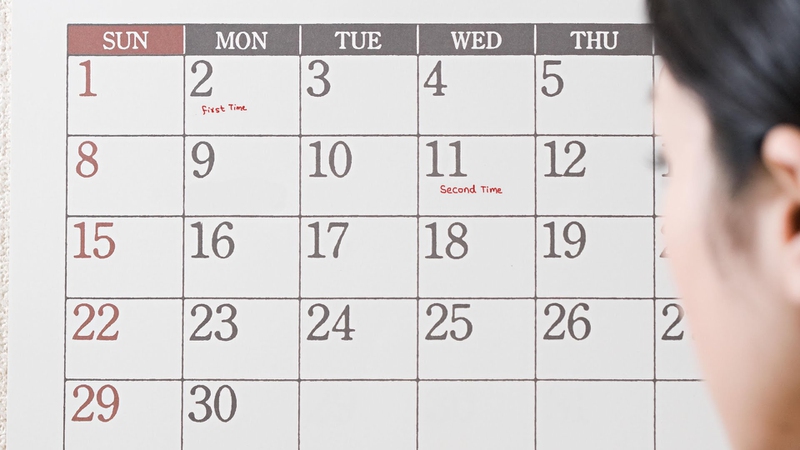Women who are trying to become pregnant or those who want to avoid hormonal birth control rely on tracking their ovulation to accomplish either of these. In order to properly plan, knowing when is the best time to have sex can help you a lot. Besides the question, many women wonder if you can ovulate twice a month while some have never thoughts of this being a possibility. To learn more about this, you'll want to read on.

Can You Ovulate Twice a Month?
For most women, only one egg in each menstrual cycle is ovulated. However, the fact that fraternal twins and multiple pregnancies do occur will let you know it's not always the case. But it doesn't mean you will ovulate twice a month, it means you can ovulate two or more eggs each time.
The Traditional Understanding of the Ovulation Process
To better understand the ovulation process and in turn, better understand how it can be possible for more than one egg to ovulate in a cycle, you will want to be clear about some of the steps in the process.
Follicles recruitment - During the luteal phase, which occurs at the end of the second half the cycle or during the follicular phase, cohorts are recruited for growth and maturity. These waves of synchronized ovarian follicles contain the eggs which are then pushed towards ovulation. The egg in each follicle is housed by a collection of special tissues and cells.
Dominant follicle - In each group of follicles, there is typically only one that obtains the qualities during the growth and development phase that will make it stand out as the dominant follicle. Ovulation twice a month can occur when there are two or more dominant follicles in a group. The dominant follicle is the one that tends to be selected for ovulation and is usually the largest in the group. At mid-cycle, the dominant follicle will measure between 18 and 20 millimeters.
Through serial ultrasounds, the growth of the follicles can be measured. This can show whether there are one or more dominant follicles that are ideal for ovulation in each cycle.
Ovulating Twice in a Cycle Possibilities
Can you ovulate twice a month and how? One theory that explains how it is possible for more than one ovulation to occur during a cycle is that there is more than one group of cohorts that can be recruited for further maturation and growth in a cycle. According to this theory then, the cohorts of maturing and growing follicles would result in recruiting to be continuous in one cycle to over a series of cycles.
Each of these groups can, therefore, produce a dominant follicle for ovulation in the same cycle. Studies that prove this occurrence include:
The Human Reproduction published a study in 2000 that showed evidence from an ultrasound of a double ovulation which can occur in 3 percent of women or 6 out of 205 women.
In 2003, Fertility and Sterility published a Canadian study indicated that all women have two cohorts in their ovaries in a given month that are contain maturing follicles. Nearly ten percent of women did ovulate twice in the same cycle.
Human Reproduction Update published a review of studies in 2012 that discussed the question of "can you ovulate twice a month". The authors of this series went into further exploration of the process of multiple cohorts producing more than one follicle for ovulation in a cycle.
The ovulation of the eggs can occur at the same time or may happen hour or days apart. Additionally, it is also possible that single cohorts can produce more than one dominant follicle instead of each dominant follicle developing from separate cohorts.
Know the Signs of Ovulation to Keep an Eye on Your Cycle
Now that you may have a better understanding of how the ovulation process works, you'll want to know how to tell when exactly you are ovulating. Whether this occurs once or twice in a cycle, these signs will give you a better idea of when you are ovulating, but keep in mind that some women may not experience any signs at all.
A change in the cervix can be a clear indication that you are ovulated. Whether the cervix is higher, more open or wetter, this can indicate ovulation
The firmness of the cervical can also be a telling sign of ovulation. During ovulation, the cervix should become softer and will be harder to prevent pregnancy when not ovulation.
Your basal body temperature will also change during ovulation. When you are ovulating, the basal body temperature will dip for a short period of time and then increase significantly the next day which is often an indication that an egg has been released.
The mucus released by the cervix will tend to be the consistency of egg whites. And more mucus tends to be released when ovulation is about to occur.
Additional signs of ovulation can include tenderness of the breasts, bloating, increase in sex drive, heightened sense such as smell or taste and cramping on one side of the pelvis.
Knowing the question of "can you ovulate twice a month" is not that crucial comparing to the signs listed above when being pregnant or not pregnant is your purpose. You can also consult a doctor to know more facts about ovulation.
View All Comments /Add Comment